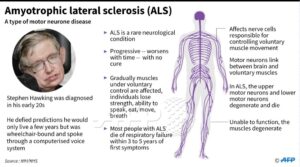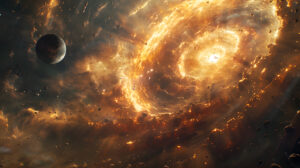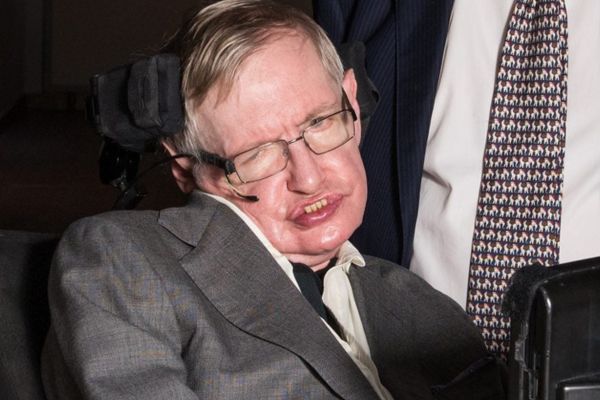Stephan Hawking’s exceptional journey of hope, resilience, and intellect unfolds insights about the structure of the Universe and its impact on celestial bodies. It opens up new ideological horizons about the eleven dimensions of the electromagnetic field. Despite his debilitating physical health, he defeated all odds with his unmet determination.
Our minds introspect several questions about how a physically disabled person could have unlocked the biggest mystery of the Universe and elaborated Albert Einstein’s “ Theory of relativity” in an altogether new dimension. This blog is just an effort to give tribute to a highly genius, the intuitive and psychic person whose physical disability did not stop his curiosity to decipher cosmology and astrophysics’ unresolved mysteries.
Did Stephan Hawking's Neurodegenerative Disease Open Up New Dimensions Of Mind Power?
Stephan Hawking lived more than five decades with Amyotrophic lateral sclerosis (ALS), which affected his neurodegenerative mechanism. ALS causes weakness in motor neurons that control the frontal lobe and lower spinal cord. The motor neuron disorder does not allow the brain to function normally and be highly productive; the worst condition of ALS transforms into frontal-temporal lobe dementia.
Due to ALS (motor neuron slow progressive disease), his lower body was paralyzed for more than twenty years. Through the one muscle in his cheek and one handy switch, he told his findings that transformed our perspective on the Universe using a speech-generating device.
Stephan Hawking was Godspeed for humanity. His critical illness, Amyotrophic lateral sclerosis (ALS), never stopped his quest for knowledge and rise in intellect. With thirty years of experience as a Professor of mathematics at the University of Cambridge, he did his spade work to build an emblem in modern physics. He was diagnosed with ALS when he was 21; due to the severity of his illness, he was not expected to see his next birthday.

Exploring Time: How Stephen Hawking Explained the Universe
He was a Lucasian Professor of Mathematics at Cambridge, which is supposed to be one of the highest posts in the world. After obtaining a Ph D degree in applied mathematics, his journey was to discover remarkable discoveries in cosmology and general relativity. He was inspired by Roger Penrose’s singularity theorem about spacetime; he used his theory to the center of black holes and the whole Universe.
He won the Adams Prize for his famous essay “Singularities and the Geometry of space-time in March 1966. In 1970, he became popular after postulating the second law of black hole dynamics. He wrote his first book ‘The Large Scale Structure of Space-Time, in 1973. He proposed ‘quantum gravity’ and ‘quantum mechanics’ theories during the late 1970’s.
Finally, his groundbreaking theories initiated ‘the Black Hole War’ in the 1980s. He co-edited the book Euclidean quantum gravity, the extended version of quantum gravity in astrophysics. From 1990 to 2000, applications of quantum mechanics emerged as hot topics for discussion in several schools of thought.
How did Stephen Hawking’s Theories Unravel the Cosmological Deepest Secrets?
Hawking’s Initial work was on Albert Einstein’s ‘general relativity’ theory. Cosmology and black holes were his primary research areas. His entire research was based on Einstein’s principle of equivalence, outlined in his renowned book “ A Brief History of Time: From the Big Bang to Black Holes.” The book unfolds the theoretical underpinning of cosmology as an underexplored branch of physics. He contemplated that cosmology is the link between astronomy and modern physics, which objectifies the concept of space and time.
Stephen Hawking sought a “Unifying theory” to bridge quantum mechanics and general relativity. These two cornerstones of modern physics describe the universe on vastly different scales: quantum mechanics governs the microscopic world of particles. At the same time, general relativity explains the large-scale structure of spacetime and gravity. However, they conflict in extreme environments like black holes. Hawking worked on integrating quantum mechanics with general relativity to reconcile them into one cohesive theory. His work on quantum gravity and efforts to combine it with Einstein’s relativity marked a significant step towards this unification.
Hawking’s efforts to unify quantum mechanics and general relativity illuminated the contradictions between the two. General relativity works well for large-scale phenomena, such as planets’ orbits and galaxies’ expansion. However, general relativity breaks down at the subatomic level (where quantum mechanics reigns). This conflict is most severe in extreme conditions, like the interior of black holes or the universe’s origin. One of Hawking’s key insights was applying quantum theory to black holes, showing that classical ideas about black holes, such as nothing escaping their gravity, are incomplete. This insight implied that general relativity alone is insufficient for understanding the universe’s most extreme environments, so searching for a unifying theory is essential.
He revamped the general theory of relativity in terms of quantum mechanics. He believes that “quarks,” or the building blocks of the Universe and Gravity, create time and space phenomena. He describes quantum gravity, which implies that gravitational forces and quantum effects exist around black holes and astrophysical bodies such as neutron stars.
The concept of a singularity is central to Hawking’s work. A singularity is a point where the gravitational field becomes infinitely strong, warping spacetime to an infinite degree. At the center of a black hole, general relativity predicts a singularity, where density becomes infinite, and the laws of physics as we know them cease to apply. Hawking and Roger Penrose demonstrated that singularities can also exist in the universe, not just inside black holes. This insight led to the realization that the universe likely began as a singularity in the Big Bang.
He describes in ‘Quantum Field Theory that quantum mechanics poses four fundamental forces of nature: electromagnetic interactions, strong and weak forces, and gravitational force, which aligns with Albert Einstein’s “general theory of relativity.” These groundbreaking theories emerged the concept of gravitational singularity, or simply space-time singularity (a condition where the intensity of gravity breaks down the spacetime itself catastrophically). Further, his work on ‘unifying theory’ further coherently clarifies the Universe structure and science of celestial bodies.
Hawking’s work supported the Big Bang theory, which posits that the universe expanded from an extremely hot, dense state approximately 13.8 billion years ago. His singularity theorems, co-developed with Penrose, indicated that the universe must have begun in a singularity—a point of infinite density and temperature under general relativity. While Hawking’s work strengthens the case for the Big Bang, he later explored whether time had a beginning. In his *no-boundary proposal*Hawking suggested that the universe might have no initial singularity but could instead be finite in time, similar to how the Earth’s surface is finite without edges.
Although Hawking was a proponent of the Big Bang model, some of his later work sought to revise the theory by eliminating the singularity that marked the Big Bang. In the “no-boundary proposal,” Hawking and physicist James Hartle argued that time and space might be finite without needing a sharp beginning or singularity, thus proposing a “smooth” origin of the universe. This contrasts with the traditional Big Bang theory, which predicts an initial singularity where physics breaks down.
Hawking's Theory Of Black Hole: A Landmark in Astrophysics
One of Hawking’s most famous contributions is his revolutionary work on black holes. In 1974, he proposed that black holes are not entirely black but emit radiation, now known as *Hawking Radiation*. This stems from quantum mechanical effects near the event horizon, the boundary beyond which nothing, not even light, can escape. According to quantum theory, virtual particle pairs constantly appear and annihilate near the event horizon. Hawking suggested that sometimes one particle falls into the black hole while the other escapes, causing the black hole to lose energy and eventually evaporate. This idea combined quantum mechanics with general relativity, showing that black holes could slowly lose mass over time and contradicting the prior belief that nothing could escape a black hole.
 In his books, he describes four laws of black hole mechanics, which are four cycles of thermodynamics of black holes. His mathematical equations underline the foundations of astrophysics by discovering the science of mysterious celestial objects. He believes that black holes could emit subatomic substances that gradually dissolve and explode into big energy blasts in their final phase. In another way, black holes are not entirely black; they remain the energy radiation center. He discovered the ‘stream of energy’ radiated by black holes in his findings, later known as ‘Hawking radiation.’
In his books, he describes four laws of black hole mechanics, which are four cycles of thermodynamics of black holes. His mathematical equations underline the foundations of astrophysics by discovering the science of mysterious celestial objects. He believes that black holes could emit subatomic substances that gradually dissolve and explode into big energy blasts in their final phase. In another way, black holes are not entirely black; they remain the energy radiation center. He discovered the ‘stream of energy’ radiated by black holes in his findings, later known as ‘Hawking radiation.’
Why Kids Love Stephen Hawking's Books: Top Ten Picks
How did Stephen Hawking inspire so many people, especially kids? His appearances in Star Trek: The Next Generation and The Simpsons showed how keenly he participated in children’s comics, movies, and books. He wrote over ten popular books for children with his daughter as a Co-author. Though he is the most famous physicist of the second half of the 20th century, he was also a pop culture bonafide. In his books, he inspired young readers with complex scientific theories. Here are the brief descriptions of his “top five” books.

- George’s Secret Key to the Universe. He co-authored this book in 2007, the story of George, who discovers a portal to the universe. He describes space-time and black holes as scientific phenomena to young readers.
- George’s Cosmic Treasure Hunt is the second book about space adventures in which George and his friend Annie explore life beyond Earth. It was the hot-selling cake in 2009, with thrilling narratives about cosmology to educate young minds.
- George and the Big Bang: In the third edition (2011), Stephan Hawkings describes the origin of the Universe and the Big Bang Theory. The books help children to learn mind-boggling scientific concepts through captivating imaginations and thrilling adventures that grasp young kids’ attention.
- George and the Unbreakable Code: In this adventurous book (2014), as a Co-author, he focussed on Machine learning and artificial intelligence for Kids by introducing the world of algorithms and AI.
- George and the Blue Moon: In the fifth series of his book, his main story characters, George and Annie, explore life on other planets, space travel, and the future of science. It is an inspiring book for children who want to pursue astronaut careers.
- George and the Ship of Time: In this adventurous edition, George unravels the concepts of time travel and the future of Earth. He discusses how sustainability is essential for climate change and how technology can transform the world.
- Unlocking the Universe: This book was a nonfictional edition, where he pays tribute to the contributions of top scientists in astrophysics, cosmology, black holes, and time-space.
- My Brief History: Although this book intended to address all genres of readers, it was the complete memoir of Stephan Hawking’s Life, his ALS sufferings, his pursuit of scientific knowledge, and his groundbreaking black hole theories.
- The Theory of Everything: Although this book was written in 2002, before the George series, its primary focus was to summarize all theories about the origin, fate, and mysteries of the Universe. This book attracted a wide range of audiences, and curious readers also found it engaging.
- Brief Answers to the Big Questions: In 2018, he wrote his last book. It addresses all the big questions that come into our minds while discussing time travel, black holes, and the theory of the unifying Universe. This book is the straightforward answer to many complex cosmology or astrophysics problems. His entire books blend scientific theories, AI algorithms, and space adventures.
In summary,
The blog questions whether Hawking’s neurodegenerative disease was his disability or his ability to think outside the box. Using the speech-generating device, he used its alma mater to unravel astrophysics to entirely different dimensions. His efforts, such as reinterpretations of the “theory of general relativity” and “Big Bang Theory” and unifying theories of “quantum mechanics,” provide relevant answers to mind-bogging concepts.
Additionally, the blog delves into his work for young children; he contributed immensely to inspiring all audiences. He wrote more than ten books on astrophysics and black hole thermodynamics. Hence, despite ALS, paralysis, and malfunctioning of speech muscles, he did the impossible things. Let us pay tribute to this outstanding scientist for his unmet conviction and quest for knowledge. Let’s think that disability is not an obstacle to success. Let’s remember this inspiring journey while combatting the biggest challenges of your life.

